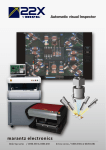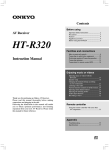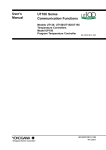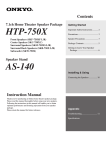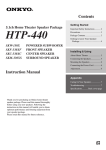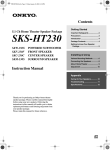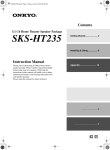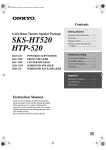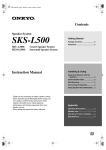Download Onkyo SKS-HT320S System
Transcript
Contents 5.1ch Home Theater Speaker Package HTP-320 SKS-HT320 SKW-320X SKF-320F SKC-320C SKM-320S POWERED SUBWOOFER FRONT SPEAKER CENTER SPEAKER SURROUND SPEAKER Getting Started Important Safeguards........................ 2 Precautions........................................ 3 Package Contents.............................. 3 Getting to Know Your Speaker Package ...................................... 4 Installing & Using About Home Theater ........................ 5 Connecting the Speakers................... 6 Connecting the Power Cord.............. 6 Adjustment........................................ 6 Appendix Caring for Your Speakers .................. 7 Troubleshooting ................................ 7 Specifications........... Back cover page Instruction Manual Thank you for purchasing an Onkyo home theater speaker package. Please read this manual thoroughly before using your new speakers. Following the instructions in this manual will enable you to obtain optimum performance and listening enjoyment from your speaker package. Please retain this manual for future reference. En WARNING: TO REDUCE THE RISK OF FIRE OR ELECTRIC SHOCK, DO NOT EXPOSE THIS APPLIANCE TO RAIN OR MOISTURE. CAUTION: TO REDUCE THE RISK OF ELECTRIC SHOCK, DO NOT REMOVE COVER (OR BACK). NO USERSERVICEABLE PARTS INSIDE. REFER SERVICING TO QUALIFIED SERVICE PERSONNEL. WARNING AVIS RISK OF ELECTRIC SHOCK DO NOT OPEN RISQUE DE CHOC ELECTRIQUE NE PAS OUVRIR The lightning flash with arrowhead symbol, within an equilateral triangle, is intended to alert the user to the presence of uninsulated “dangerous voltage” within the product’s enclosure that may be of sufficient magnitude to constitute a risk of electric shock to persons. The exclamation point within an equilateral triangle is intended to alert the user to the presence of important operating and maintenance (servicing) instructions in the literature accompanying the appliance. Important Safeguards 1. Read Instructions – All the safety and operating instructions should be read before the appliance is operated. 2. Retain Instructions – The safety and operating instructions should be retained for future reference. 3. Heed Warnings – All warnings on the appliance and in the operating instructions should be adhered to. 4. Follow Instructions – All operating and use instructions should be followed. 5. Cleaning – Unplug the appliance from the wall outlet before cleaning. The appliance should be cleaned only as recommended by the manufacturer. 6. Attachments – Do not use attachments not recommended by the appliance manufacturer as they may cause hazards. 7. Water and Moisture – Do not use the appliance near water –for example, near a bath tub, wash bowl, kitchen sink, or laundry tub; in a wet basement; or near a swimming pool; and the like. 8. Accessories – Do not place the appliance on an unstable cart, stand, tripod, bracket, or table. The appliance may fall, causing serious injury to a child or adult, and serious damage to the appliance. Use only with a cart, stand, tripod, bracket, or table recommended by the manufacturer, or sold with the appliance. Any mounting of the appliance should follow the manufacturer’s instructions, and should use a mounting accessory recommended by the manufacturer. PORTABLE CART WARNING 9. An appliance and cart combination should be moved with care. Quick stops, excessive force, and uneven surfaces may cause the appliance and cart combination to overturn. S3125A 10. Ventilation – Slots and openings in the cabinet are provided for ventilation and to ensure reliable operation of the appliance and to protect it from overheating, and these openings must not be blocked or covered. The openings should never be blocked by placing the appliance on a bed, sofa, rug, or other similar surface. The appliance should not be placed in a built-in installation such as a bookcase or rack unless proper ventilation is provided. There should be free space of at least 20 cm (8 in.) and an open- 2 ing behind the appliance. 11. Power Sources – The appliance should be operated only from the type of power source indicated on the marking label. If you are not sure of the type of power supply to your home, consult your appliance dealer or local power company. 12. Grounding or Polarization – The appliance may be equipped with a polarized alternating current line plug (a plug having one blade wider than the other). This plug will fit into the power outlet only one way. This is a safety feature. If you are unable to insert the plug fully into the outlet, try reversing the plug. If the plug should still fail to fit, contact your electrician to replace your obsolete outlet. Do not defeat the safety purpose of the polarized plug. 13. Power-Cord Protection – Power-supply cords should be routed so that they are not likely to be walked on or pinched by items placed upon or against them, paying particular attention to cords at plugs, convenience receptacles, and the point where they exit from the appliance. 14. Lightning – For added protection for the appliance during a lightning storm, or when it is left unattended and unused for long periods of time, unplug it from the wall outlet and disconnect the antenna or cable system. This will prevent damage to the appliance due to lightning and power-line surges. 15. Overloading – Do not overload wall outlets, extension cords, or integral convenience receptacles as this can result in a risk of fire or electric shock. 16. Object and Liquid Entry – Never push objects of any kind into the appliance through openings as they may touch dangerous voltage points or shortout parts that could result in a fire or electric shock. Never spill liquid of any kind on the appliance. 17. Servicing – Do not attempt to service the appliance yourself as opening or removing covers may expose you to dangerous voltage or other hazards. Refer all servicing to qualified service personnel. Important Safeguards—Continued 18. Damage Requiring Service – Unplug the appliance from the wall outlet and refer servicing to qualified service personnel under the following conditions: A. When the power-supply cord or plug is damaged, B. If liquid has been spilled, or objects have fallen into the appliance, C. If the appliance has been exposed to rain or water, D. If the appliance does not operate normally by following the operating instructions. Adjust only those controls that are covered by the operating instructions as an improper adjustment of other controls may result in damage and will often require extensive work by a qualified technician to restore the appliance to its normal operation, E. If the appliance has been dropped or damaged in any way, and F. When the appliance exhibits a distinct change in performance – this indicates a need for service. 19. Replacement Parts – When replacement parts are required, be sure the service technician has used replacement parts specified by the manufacturer or have the same characteristics as the original part. Unauthorized substitutions may result in fire, electric shock, or other hazards. 20. Safety Check – Upon completion of any service or repairs to the appliance, ask the service technician to perform safety checks to determine that the appliance is in proper operation condition. 21. Wall or Ceiling Mounting – The appliance should be mounted to a wall or ceiling only as recommended by the manufacturer. 22. Heat – The appliance should be situated away from heat sources such as radiators, heat registers, stoves, or other appliances (including amplifiers) that produce heat. 23. Liquid Hazards – The appliance should not be exposed to dripping or splashing and no objects filled with liquids, such as vases should be placed on the appliance. Precautions 1. AC Fuse The fuse is located inside the chassis and is not userserviceable. If power does not come on, contact your Onkyo authorized service station. 2. Care From time to time you should wipe off the front and rear panels and the cabinet with a soft cloth. For heavier dirt, dampen a soft cloth in a weak solution of mild detergent and water, wring it out dry, and wipe off the dirt. Following this, dry immediately with a clean cloth. Do not use rough material, thinners, alcohol or other chemical solvents or cloths since these may damage the finish or remove the panel lettering. Use a vacuum cleaner to remove dust from hard-to-reach grilles. 3. Power WARNING BEFORE PLUGGING IN THE UNIT FOR THE FIRST TIME, READ THE FOLLOWING SECTION CAREFULLY. The voltage of the available power supply differs according to country or region. Be sure that the power supply voltage of the area where this unit will be used meets the required voltage (e.g., AC 120 V, 60 Hz) written on the rear panel. Package Contents Make sure your box contains all of the items below. If anything is missing, contact the nearest Onkyo dealer. • Center speaker • Surround speakers • Subwoofer • Front speakers (SKF-320F) (SKC-320C) (SKM-320S) (SKW-320X) • Speaker cable for front speakers 15 ft. (4.5 m) (Red) (White) • Speaker cable for center speaker 10 ft. (3 m) (Green) • Speaker cables for surround speakers 30 ft. (9 m) (Blue) • RCA cable for subwoofer connection (Gray) The alphabet displayed at the end of the product name found in catalogs and on package represents the color of HTP-320. Though the color varies, the specifications and operations are the same. 3 Getting to Know Your Speaker Package Subwoofer (SKW-320X) ■ Rear OUTPUT LEVEL MIN LINE INPUT MAX RED : STANDBY GREEN : ON 2 1 3 To AC outlet 1 STANDBY/ON indicator Red: Subwoofer in standby mode Green: Subwoofer on With the Auto Standby function, the SKW-320X automatically turns on when an input signal is detected in Standby mode. When there’s no input signal for a while, the SKW-320X automatically enters Standby mode. 2 OUTPUT LEVEL control This control is used to adjust the volume of the subwoofer. 3 LINE INPUT This RCA input should be connected to the subwoofer preout on your AV receiver, or other receiver with supplied RCA cable. Note: The Auto Standby function turns the subwoofer on when the input signal exceeds a certain level. If the Auto Standby function does not work reliably, try slightly increasing or decreasing the subwoofer output level on your receiver or amp. Front, Center & Surround Speakers (SKF-320F, SKC-320C, SKM-320S) ■ Rear 2 1 1 Speaker terminals These push terminals are for connecting the speaker to your HT-R320, or other receiver with the supplied speaker cables. The supplied speaker cables are color-coded for easy identification. Simply connect each cable to the same colored positive speaker terminal. 2 Keyhole slot These keyhole slots can be used to wall-mount the speaker. 4 About Home Theater Enjoying Home Theater The HTP-320’s great sound means that you can enjoy surround sound with a real sense of movement in your own home—just like being in a movie theater or concert hall. Center speaker This speaker enhances the front left and right speakers, making sound movements distinct and providing a full sound image. In movies it’s used mainly for dialog. Position it close to your TV facing forward at about ear level, or at the same height 1/3 as the front left and right speakers. Put it somewhere where it won’t slide around or fall. Front left and right speakers These output the overall sound. Their role in a home theater is to provide a solid anchor for the sound image. They should be positioned facing the listener at about ear level, and equidistant from the TV. Angle them inward so as to create a triangle, with the listener at the apex. 1/3 1/3 Right Subwoofer The subwoofer handles the bass sounds of the LFE (Low-Frequency Effects) channel. The volume and quality of the bass output from your subwoofer will depend on its position, the shape of your Left listening room, and your listening position. In general, a good bass sound can be obtained by installing the subwoofer in a front corner, or at one-third the width of the wall, as shown. (SKM-320S) (SKM-320S) Surround left and right speakers These speakers are used for precise sound positioning and to add realistic ambience. Position them at the sides of the listener, or slightly behind, about 2–3 feet (60–100 cm) above ear level. Ideally they should be equidistant from the listener. Wall-mounting the surround speakers If the surround speakers are to be wall-mounted, make sure that the walls are strong enough to support the speaker’s weight. The weight that mounting screws can support varies greatly depending on the wall material and the position of the reinforcing ribs embedded in the wall. Use long screws with a head diameter of 1/4 inch (6.3 mm) or less and a shank diameter of 1/8 inch (3.5 mm) or less. (We recommend that you consult a home installation professional.) 5 Connecting the Speakers Connecting the Power Cord Read the following before connecting your speakers: • Turn off your amp before making any connections. • Pay close attention to speaker wiring polarity. Connect positive (+) terminals to only positive (+) terminals, and negative (–) terminals to only negative (–) terminals. If the speakers are wired incorrectly, the sound will be out of phase and will sound unnatural. • Be careful not to short the positive and negative wires. Doing so may damage your amp. Notes: • Before connecting the power cord, connect all of your speakers and AV components. • Turning on the SKW-320X may cause a momentary power surge that might interfere with other electrical equipment o the same circuit. If this is a problem, plug the SKW-320X into a different branch circuit. Adjustment Setting the Subwoofer Level Connecting the Speaker Cables 1 Use the cables to connect each speaker’s input terminals to the corresponding speaker output terminals on your HT-R320 or other receiver. To make a connection, while pressing the terminal lever, insert the wire into the hole, and then release the lever. Make sure that the terminals are gripping the bare wires, not the insulation. To set the level of the subwoofer, use the OUTPUT LEVEL control. Set it so that bass sounds are evenly balanced with the treble sounds from the other speakers. Because our ears are less sensitive to very low bass sounds, there’s a temptation to set the level of the subwoofer too high. As a rule of thumb, set the subwoofer level to what you think is the optimal level, and then back it off slightly. OUTPUT LEVEL MIN Connecting the Subwoofer 1 6 Using the supplied RCA cable, connect the subwoofer’s LINE INPUT to your amp’s SUBWOOFER PREOUT. MAX Caring for Your Speakers Placement • The speaker cabinets are made out of wood and are therefore sensitive to extreme temperatures and humidity, do not put them in locations subject to direct sunlight or in humid places, such as near an air conditioner, humidifier, bathroom, or kitchen. • Do not put water or other liquids close to the speakers. If liquid is spilled over the speakers, the drive units may be damaged. • Speakers should only be placed on sturdy, flat surfaces that are free from vibration. Putting them on uneven or unstable surfaces, where they may fall and cause damage, will affect the sound quality. • Subwoofer is designed to be used in the upright vertical position only. Do not use it in the horizontal or tilted position. • If the unit is used near a turntable or CD player, howling or slipping of sound may occur. To prevent this, move the unit away from the turntable or CD player otherwise lower the unit’s output level. Using Close to a TV or Computer TVs and computer monitors are magnetically sensitive devices and as such are likely to suffer discoloration or picture distortion when conventional speakers are placed nearby. To prevent this, the SKF-320F and SKC-320C speakers feature internal magnetic shielding. In some situations, however, discoloration may still be an issue, in which case you should turn off your TV or monitor, wait 15 to 30 minutes, and then turn it back on again. This normally activates the degaussing function, which neutralizes the magnetic field, thereby removing any discoloration effects. If discoloration problems persist, try moving the speakers away from your TV or monitor. Note that discoloration can also be caused by a magnet or demagnetizing tool that’s too close to your TV or monitor. Do not place SKM-320S close to TV or a computer monitor because it has no magnetic shield. Operating Precautions The HTP-320 speakers can handle the specified input power when used for normal music reproduction. If any of the following signals are fed to them, even if the input power is within the specified rating, excessive current may flow in the speaker coils, causing burning or wire breakage: 1. Interstation noise from an untuned FM radio. 2. Sound from fast-forwarding a cassette tape. 3. High-pitched sounds generated by an oscillator, electronic musical instrument, and so on. 4. Amplifier oscillation. 5. Special test tones from audio test CDs and so on. 6. Thumps and clicks caused by connecting or disconnecting audio cables (Always turn off your amplifier before connecting or disconnecting cables.) 7. Microphone feedback. Speaker Care Wipe the cabinet occasionally with a dry silica or soft cloth. For heavier dirt, after dampening a soft cloth in a weak solution of mild detergent and water and wringing it out dry, wipe off the dirt. Then, dry immediately with a clean cloth. Do not use rough material, thinners, alcohol or other chemical solvents or cloths since these could damage the finish, remove the panel lettering, or cause discoloration. If you are using a chemical cloth, always follow the instructions that come with the cloth. For dust accumulated on grilles, use a vacuum cleaner or brush it off. Troubleshooting Symptom There’s no sound coming from certain speakers? The subwoofer does not turn on? The subwoofer produces no sound? The subwoofer produces hardly any sound? A humming sound can be heard from the subwoofer? Possible cause Remedy The speaker cables are not connected properly. Check the speaker cables and correct as necessary. The number of speaker channels is not set to 5ch on the HT-R320. Set the number of speaker channels to 5ch. The power plug is not fully inserted into the wall outlet. Insert the power plug fully into the wall outlet. The OUTPUT LEVEL control is set to minimum. Turn up the OUTPUT LEVEL control. The RCA cable is not properly connected to the subwoofer’s LINE INPUT. Make sure that the RCA cable is properly connected to the subwoofer’s LINE INPUT. The level of the input signal was too low and the subwoofer entered Standby mode. Slightly increase the subwoofer preout output level on your amp. On the HT-R320 Receiver, the subwoofer mode is set to SW Off. Set the subwoofer mode to something other than SW Off. The source material contain little or no bass content. Choose source material with more bass content. The RCA cable is not properly connected to the subwoofer’s LINE INPUT. Make sure that the RCA cable is properly connected to the subwoofer’s LINE INPUT. External interference from a TV or other electronic device is being picked up. Move the subwoofer and RCA cable away from the interference source. Make sure your audio system is grounded properly. 7 Specifications ■ Powered Subwoofer (SKW-320X) Type: Input sensitivity/impedance: Maximum output power: Frequency response: Cabinet capacity: Dimensions (W × H × D): Weight: Speaker: Power supply: Power consumption: Other: Powered Bass-reflex 220 mV /15 kΩ 100 W (Dynamic Power) 35 Hz–150 Hz 0.91 cubic feet (26 Litter) 9-1/16 × 17-13/16 × 15-7/8 inch (230 × 436 × 404 mm) 24.7 lbs (11.2 kg) 8 inch Cone AC 120 V, 60 Hz 75 W Auto-standby function ■ Front Speaker (SKF-320F) Type: Impedance: Maximum input power: Output sound pressure level: Frequency response: Crossover frequency: Cabinet capacity: Dimensions (W × H × D): Weight: Speaker: Woofer: Tweeter: Terminal: Other: 2 Way Bass-reflex 8Ω 100 W 76 dB/W/m 70 Hz–50 kHz 4.5 kHz 0.035 cubic feet (1.0 Litter) 4 × 6-5/8 × 4-15/16 inch (101 × 169 × 126 mm) 2.6 lbs (1.2 kg) 3-1/8 inch Cone 1 inch Balanced Dome Spring type Color coded Magnetic shielding ■ Center Speaker (SKC-320C) Type: Impedance: Maximum input power: Output sound pressure level: Frequency response: Crossover frequency: Cabinet capacity: Dimensions (W × H × D): Weight: Speaker: Woofer: Tweeter: Terminal: Other: 2 Way Bass-reflex 8Ω 100 W 78 dB/W/m 70 Hz–50 kHz 4.5 kHz 0.057 cubic feet (1.6 Litter) 10-3/8 × 4 × 4-15/16 inch (264 × 101 × 126 mm) 4.4 lbs (2.0 kg) 3-1/8 inch Cone x 2 1 inch Balanced Dome Spring type Color coded Magnetic shielding ■ Surround Speaker (SKM-320S) Type: Impedance: Maximum input power: Output sound pressure level: Frequency response: Crossover frequency: Cabinet capacity: Dimensions (W × H × D): Weight: Speaker: Woofer: Tweeter: Terminal: 2 Way Bass-Reflex 8Ω 100 W 79 dB/W/m 70 Hz–30 kHz 10 kHz 0.035 cubic feet (1.0 Litter) 4 × 6-5/8 × 4-15/16 inch (101 × 169 × 126mm) 1.8 lbs. (0.8 kg) 3-1/8 inch Cone Woofer 3/4 inch Celamic Tweeter Spring type Color coded Specifications and appearance are subject to change without prior notice. Sales & Product Planning Div. : 2-1, Nisshin-cho, Neyagawa-shi, OSAKA 572-8540, JAPAN Tel: 072-831-8023 Fax: 072-831-8124 ONKYO U.S.A. CORPORATION 18 Park Way, Upper Saddle River, N.J. 07458, U.S.A. Tel: 201-785-2600 Fax: 201-785-2650 http://www.onkyousa.com ONKYO EUROPE ELECTRONICS GmbH Liegnitzerstrasse 6, 82194 Groebenzell, GERMANY Tel: +49-8142-4401-0 Fax: +49-8142-4401-555 http://www.onkyo.net ONKYO EUROPE UK Office Suite 1, Gregories Court, Gregories Road, Beaconsfield, Buckinghamshire, HP9 1HQ UNITED KINGDOM Tel: +44-(0)1494-681515 Fax: +44(0)-1494-680452 ONKYO CHINA LIMITED Units 2102-2107, Metroplaza Tower I, 223 Hing Fong Road, Kwai Chung, N.T., HONG KONG Tel: 852-2429-3118 Fax: 852-2428-9039 HOMEPAGE http://www.onkyo.com/ SN 29343900 (C) Copyright 2004 ONKYO CORPORATION Japan. All rights reserved. 8 D0407-1








